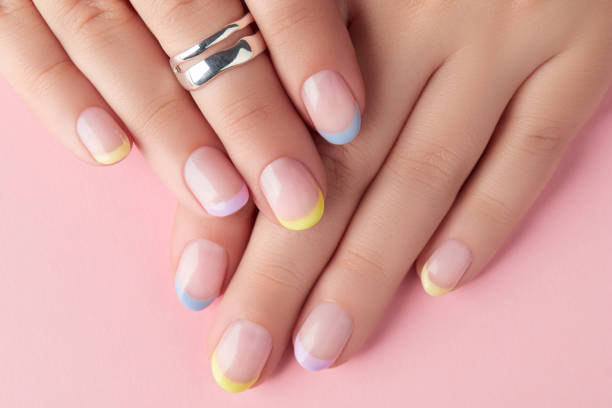French Nails: The Timeless Elegance of a Classic Manicure

French Nails: The Timeless Elegance of a Classic Manicure
The French manicure is a timeless and iconic nail design that has been synonymous with elegance and sophistication for decades. Known for its clean, minimalist look, French nails feature a natural base with white tips, giving them a fresh, polished appearance. Whether you’re preparing for a special occasion, a casual outing, or simply want to maintain well-groomed nails, French nails offer a versatile and stylish option. But how did French nails come to be, and why do they remain so popular today?
In this comprehensive guide, we’ll explore everything you need to know about French nails, from their history and evolution to how you can achieve this classic look at home or in the salon. Whether you’re a French manicure newbie or a seasoned pro, this article will help you understand why French nails continue to be a top choice for many nail enthusiasts.
What Are French Nails?
French nails refer to a manicure style characterized by a pale pink or beige base with bright white tips. This classic look is meant to mimic the natural color of the nail, with the white tips representing the free edge of the nail, and the neutral base creating a fresh, clean canvas.
While the traditional French manicure uses a subtle pink or beige color for the base, modern interpretations have expanded to include different shades of white, bold-colored tips, and even intricate nail art designs. Despite these variations, the French manicure’s hallmark remains its understated elegance, which is perfect for both formal and casual settings.
Characteristics of French Nails:
- Natural Base: Typically, the base is a soft, nude or pink shade, designed to resemble the natural color of the nail.
- White Tips: The tips of the nails are painted white, providing a bright contrast to the natural base.
- Clean, Polished Look: French nails are designed to have a neat and polished appearance, with no visible streaks or imperfections.
The History of French Nails
The French manicure has a fascinating history that dates back several decades, and although it’s called “French,” it actually has roots in the United States. The style was created in the 1970s by Jeff Pink, a California-based nail technician and founder of the nail care brand ORLY. He was tasked with designing a nail look that would be versatile for models in the fashion industry, one that would complement various outfits and be suitable for photo shoots without clashing with clothes or accessories.
In response to this challenge, Jeff Pink developed the classic French manicure with its neutral base and white tips. He dubbed it the “French manicure” because of its association with Parisian chic and elegance. The look was instantly popular and became a staple in the fashion and beauty industries, eventually spreading to the mainstream.
Over time, French nails evolved. Today, there are many variations of the French manicure, including reverse French nails (where the tips are painted in colors other than white), ombre French nails (where the tips fade into the base color), and modern twists that incorporate bold, vibrant colors or unique patterns.
Why Are French Nails So Popular?
French nails have remained a favorite for so long for several reasons:
1. Timeless Elegance
The understated beauty of French nails gives them a sophisticated, chic look that can complement any outfit or occasion. Whether you’re attending a wedding, going to work, or out for a night on the town, French nails are versatile enough to match any style.
2. Clean and Natural Look
French nails provide a clean and natural look, which is why they are so appealing to those who prefer a minimalist style. The neutral base color enhances the natural appearance of the nails, while the white tips offer a touch of brightness.
3. Easy to Maintain
Unlike other nail designs, which can require frequent touch-ups and intricate designs, French nails are relatively easy to maintain. The subtle design allows for a longer-lasting manicure that doesn’t easily show chips or wear, making it perfect for people with busy lifestyles.
4. Professional and Polished
For many people, French nails represent professionalism and refinement. The clean lines and neutral tones make French nails ideal for business settings, interviews, or any occasion where a polished, sophisticated appearance is desired.
5. Customizable
While the traditional French manicure features pink or nude bases with white tips, modern variations allow for endless customization. Whether you prefer bold tips, metallic accents, or intricate nail art, French nails can be personalized to reflect your style and personality.
How to Achieve Perfect French Nails at Home
While getting a professional French manicure at a salon is always an option, you can also achieve the perfect French nails at home with the right tools and techniques. Here’s a step-by-step guide on how to create your own French nails:
What You’ll Need:
- Nail Polish Remover: To clean your nails before starting.
- Base Coat: To protect your natural nails and ensure the polish adheres better.
- French Manicure Kit or White Nail Polish: You can buy a French manicure kit with pre-designed tips or use regular white polish for the tips.
- Nude or Light Pink Nail Polish: This will be the base color for your nails.
- Nail Tape or French Tip Guides: These will help you achieve clean, straight lines for the white tips.
- Top Coat: To protect your manicure and give it a glossy finish.
- Cotton Swabs and Nail Polish Remover: For any clean-up around the edges.
Step-by-Step Instructions:
Step 1: Prep Your Nails
Start by removing any old nail polish with nail polish remover. Next, shape your nails using a nail file to achieve the desired length and shape, whether that’s square, oval, or almond-shaped. Push back your cuticles with a cuticle pusher for a neat appearance.
Step 2: Apply the Base Coat
Apply a thin layer of base coat to each nail. This will help protect your nails from staining and create a smooth surface for the polish. Allow it to dry completely before moving on to the next step.
Step 3: Apply the Base Color
Once the base coat is dry, apply two coats of a nude or light pink nail polish. The base color should be as close to the natural color of your nails as possible, creating a neutral, clean look. Let each coat dry completely before applying the next.
Step 4: Create the White Tips
Using either a French manicure kit or white nail polish, carefully paint the tips of your nails. To achieve the classic French tip, you can use French tip guides or nail tape to mark off the area where the white polish should be applied. The white tips should be thin but bold enough to stand out.
If you’re freehanding the tips, take your time to create a smooth, curved line at the tip of each nail. You can dip a small brush or a cotton swab into nail polish remover to clean up any mistakes along the edges.
Step 5: Apply the Top Coat
Once the white tips are dry, apply a glossy top coat over the entire nail to seal in the color and give your French nails a shiny, professional finish. This will also help your manicure last longer and prevent chips.
Step 6: Clean Up
Finally, dip a cotton swab in nail polish remover to clean up any excess polish around your nails and cuticles. This will help your French nails look sharp and polished.
Different Variations of French Nails
While the classic French manicure remains a favorite, there are several exciting variations that allow you to put a personal spin on this timeless design. Here are a few popular options:
1. Reverse French Manicure
In a reverse French manicure, the design is flipped so that the white tips are applied near the base of the nail (around the cuticle area) rather than at the free edge. This style creates a dramatic contrast and can be done with various colors, including metallics or pastels.
2. Colored French Tips
Instead of the traditional white tips, try using a bold color for the tips. Popular choices include black, red, blue, or even neon shades. This variation adds a modern twist to the classic look, making it more fun and eye-catching.
3. Ombre French Nails
Ombre French nails feature a gradual color transition from the base of the nail to the tips. This design can be done with any color combination, but common choices include pink-to-white or purple-to-silver. The ombre effect adds a soft, elegant touch to the classic French style.
4. Glitter French Nails
If you love sparkle, try incorporating glitter into your French manicure. You can apply glitter polish over the tips or use it to add subtle accents along the edges of the nail for a more festive look.
5. Floral or Geometric French Nails
For those who want to add a little more creativity to their French nails, consider incorporating nail art designs such as flowers, stripes, or geometric patterns. The classic French style can serve as a great base for various artistic expressions.
Why French Nails Are Perfect for Special Occasions
French nails are particularly popular for weddings, anniversaries, and other special occasions because they offer a timeless, elegant look that pairs well with virtually any outfit. Whether you’re the bride, part of the wedding party, or simply a guest, French nails complement both formal and casual attire.
Weddings
French nails are a wedding favorite because of their timeless appeal. Brides often choose this style for its simplicity and beauty, knowing it will match their wedding dress and complement the overall
theme of their special day. The clean and classic design is subtle yet sophisticated, ensuring that your nails look perfect in all the wedding photos.
Professional Events
French nails are also a popular choice for interviews, business meetings, and other professional events. They give off an air of confidence, refinement, and attention to detail, which are qualities that leave a lasting impression.
Casual Settings
While French nails are often associated with formal occasions, they’re versatile enough to work in casual settings too. Whether you’re going to lunch with friends or running errands, French nails always look well-groomed and polished without being overly flashy.
Conclusion
French nails remain a go-to choice for anyone looking to achieve a polished, elegant, and versatile look. Whether you choose the classic white tips or opt for a modern twist, French nails continue to be a symbol of sophistication and beauty. With their timeless appeal and wide range of customization options, French nails are a manicure style that will never go out of fashion. Whether you’re getting them done at a salon or perfecting them at home, French nails are the epitome of classic style, making them a perfect choice for any occasion.
